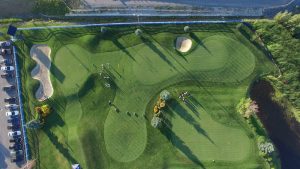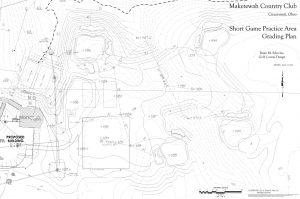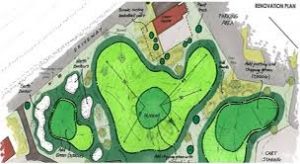Over the past few years short-game practice areas are all the rave. And wow they are a lot of fun to design! We can throw all the standards and a majority of rules out the window when putting pencil to paper since these facilities are for practice! Safety and flexibility in use are the main concerns.
Look at all the great examples we have from the Himalayas putting course at the Old Course in St. Andrews, Scotland to your local, proactive golf club.
Players know that the key to scoring well is around the green. How many times have you chipped and two putted?

So what does a short-game area need to be successful? Location, location, and location – unless you are a resort course where taking an extended lesson or group clinic fits into your week off – have the facility near the clubhouse, existing practice facility, and better yet, first tee is paramount. I view the location as a social stimulant. Build something in back behind the maintenance shed and well, the maintenance crew’s handicap will go down. Build it off the member’s locker rooms and you may end up putting in lights.
But does size matter? Does what you are practicing matter? Short game is practicing touch and recovery shots, not taking scalps. Divots are not part of short-game practice. Putting on the greens, or at least having the ball react like it does on the big boy course is a necessity. Forty yards seem to work well as a maximum distance that minimizes wayward shots. How many times have you hit a forty yard flyer? Vary the angle and targets so as many people can practice as possible. What about placement? Do what best fits the terrain and extrudes practice potential, such as Fiddler Elbow CC’s one-central green or four greens at the corners like at Maketewah

Greens need to be large enough for the ball to react. Twenty feet is as the minimum – unless you’re coming out of a deep greenside bunker. A forty yard approach might equal forty feet of receptive green. Twelve-hundred total square feet might do it in some compact situations, while twenty-five hundred square feet might be best for an average sized facility.
Is a green too large? Remember the Himalayas! Keep the green movement as simple and elegant as possible. We are not looking for a biarritz swale or even a double-plateau terrace, though give me some extra space and watch out! Golden-aged golf architect Seth Raynor is rolling over in his grave! Pitch the green slope away from the bunker in one section and towards the bunker in another. Does your course have collection areas, a’ la Pinehurst #2? Combine the close-cut mown areas into multiple hitting ‘stations’ that vary in distance, define with rough, or even exposed ledge.

If you are a C.B. Macdonald course, don’t build it to look like Tom Simpson made a special trip from Woking GC. Style it to match your landscape, both in terrain and vegetation. If your course has approach bunkers, include one like I did at New Haven CC. Can you combine a greenside bunker with an opening into the practice range for fairway shots? Are your greens “up greens” that don’t allow ‘run ons’ or are a majority of your approaches open to bounce and bump the ball onto the putting surface? Are your green fronts closed with a bunker forcing a carry?
Include all the elements, even a few trees to punch out from. That’s where you’ll find me.

Leave a Reply